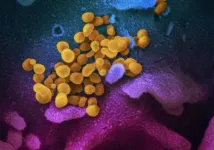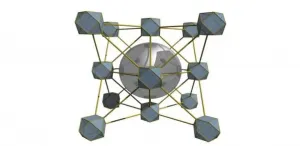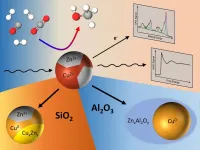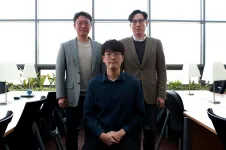Want to cut emissions that cause climate change? Tax carbon
Carbon taxes are cheaper, more efficient than other policies, study finds
2021-03-04
(Press-News.org) COLUMBUS, Ohio - Putting a price on producing carbon is the cheapest, most efficient policy change legislators can make to reduce emissions that cause climate change, new research suggests.
The case study, published recently in the journal Current Sustainable/Renewable Energy Reports, analyzed the costs and effects that a variety of policy changes would have on reducing carbon dioxide emissions from electricity generation in Texas and found that adding a price, based on the cost of climate change, to carbon was the most effective.
"If the goal is reducing carbon dioxide in the atmosphere, what we found is that putting a price on carbon and then letting suppliers and consumers make their production and consumption choices accordingly is much more effective than other policies," said Ramteen Sioshansi, senior author of the study and an integrated systems engineering professor at The Ohio State University.
The study did not examine how policy changes might affect the reliability of the Texas power system - an issue that became acute and painful for Texas residents last month when a winter storm caused the state's power grid to go down.
But it did evaluate other policies, including mandates that a certain amount of energy in a region's energy portfolio come from renewable sources, and found that they were either more expensive or not as effective as carbon taxes at reducing the amount of carbon dioxide in the air. Subsidies for renewable energy sources were the also not as effective at reducing carbon dioxide, the study found.
The researchers modeled what might happen if the government used these various methods to cut carbon emission to be 80% below the 2010 level by the end of 2040.
They found that carbon taxes on coal and natural-gas-fired producing units could achieve those cuts at about half the cost of tax credits for renewable energy sources.
The study was led by Yixian Liu, a former graduate student in Sioshansi's lab, who is now a research scientist at Amazon. It modeled the expenses and carbon reductions possible from five generation technologies - wind, solar, nuclear, natural gas and coal-fired units - along with the costs and carbon reductions associated with storing energy. Storing energy is crucial, because it allows energy systems to manage renewable energy resources as sources shift from climate-change-causing fossil fuels - natural gas and coal - to cleaner sources like wind and solar.
Sioshansi said the results of the study were not surprising, given that a similar program has been in use to reduce levels of sulfur dioxide, one of the chemicals that causes acid rain.
"We have known for the last 40 or more years that market-based solutions can work on issues like this," Sioshansi said.
Although subsidies for renewable sources would work to decrease carbon emissions, the costs of those subsidies would be an issue, the study found.
"If no one had to pay for the subsidies and they were truly free, that would be a great option," Sioshansi said. "Unfortunately, that is not how they work."
INFORMATION:
CONTACT:
Ramteen Sioshansi,
sioshansi.1@osu.edu
Written by Laura Arenschield,
arenschield.2@osu.edu
ELSE PRESS RELEASES FROM THIS DATE:
2021-03-04
In order to show the clinical relevance of a difference between two treatment alternatives, in recent years, the manufacturer dossiers submitted in early benefit assessments of new drugs have increasingly contained responder analyses for patient-relevant outcomes. In such analyses, it is investigated whether the proportion of patients experiencing a noticeable change in the respective outcome differs between the two treatment groups in a study. This involves information on health-related quality of life or on individual symptoms such as pain or itching, which patients recorded with the help of scales in questionnaires.
But what difference makes a change relevant for the individual? That is, at what threshold can a response to an intervention be derived for ...
2021-03-04
A deep sequencing study of 747 SARS-CoV-2 virus isolates has revealed mutant peptides derived from the virus that cannot effectively bind to critical proteins on the surface of infected cells and, in turn, hamper activation of CD8+ killer T cells that recognize and destroy these infected cells. These peptides, the authors say, represent one way the coronavirus subverts killer T cell responses and stymies immunity in the host. Their results may be of particular importance for SARS-CoV-2 subunit vaccines, such as the RNA vaccines currently in use, which induce responses against a limited number of viral ...
2021-03-04
There are no therapeutics available that have been developed for COVID-19 treatment. Repurposing of already available medication for COVID-19 therapy is an attractive option to shorten the road to treatment development. The drug Camostat could be suitable. Camostat exerts antiviral activity by blocking the protease TMPRSS2, which is used by SARS-CoV-2 for entry into cells. However, it was previously unknown whether SARS-CoV-2 can use TMPRSS2-related proteases for cell entry and whether these proteases can be blocked by Camostat. Moreover, it was unclear whether metabolization of Camostat interferes with antiviral activity. An international team of researchers around Markus Hoffmann and Stefan Pöhlmann ...
2021-03-04
Solving a Genetic Mystery at the Heart of the COVID-19 Pandemic
As the COVID-19 pandemic enters its second year, scientists are still working to understand how the new strain of coronavirus evolved, and how it became so much more dangerous than other coronaviruses, which humans have been living alongside for millennia.
Virologists and epidemiologists worldwide have speculated for months that a protein called ORF8 likely holds the answer, and a recent study by Berkeley Lab scientists has helped confirm this hypothesis.
In a paper published in mBio, lead author Russell Neches and his colleagues ...
2021-03-04
By embedding a silver catalyst inside a porous crystal, KAUST researchers have improved a chemical reaction that converts carbon dioxide (CO2) into carbon monoxide (CO), which is a useful feedstock for the chemical industry.
Carbon monoxide is a building block for producing hydrocarbon fuels, and many researchers are searching for ways to produce it from CO2, a greenhouse gas emitted by burning fossil fuels. One strategy involves using electricity and a catalyst to drive a so-called CO2 reduction reaction. But this reaction typically produces a variety of other products, including methane, methanol and ethylene. Separating these products significantly raises the cost of the process, ...
2021-03-04
A study on big droughts in the Greater Mekong region revealed findings that can help reduce the carbon footprint of power systems while providing insights into better designed and more sustainable power plants.
The study, titled 'The Greater Mekong's climate-water-energy nexus: how ENSO-triggered regional droughts affect power supply and CO2 emissions', was published by researchers from the Singapore University of Technology and Design (SUTD) and the University of California, Santa Barbara, in the journal Earth's Future.
Known as an important means to support economic growth in Southeast Asia, the hydropower resources of the Mekong River Basin have been largely exploited by the riparian countries. The researchers ...
2021-03-04
The current commercial production of methanol through the hydrogenation of the green-house gas CO2 relies on a catalyst consisting of copper, zinc oxide and aluminum oxide. Even though this catalyst has been used for many decades in the chemical industry, unknowns still remain. A team of researchers from the Interface Science Department of the Fritz-Haber-Institute of the Max Planck Society, the Ruhr-University Bochum, Stanford Linear Accelerator Center (SLAC), FZ Juelich and Brookhaven National Laboratory have now elucidated the origin of intriguing catalytic activity and selectivity trends of complex nanocatalysts ...
2021-03-04
In 2015, hackers infiltrated the corporate network of Ukraine's power grid and injected malicious software, which caused a massive power outage. Such cyberattacks, along with the dangers to society that they represent, could become more common as the number of cyber-physical systems (CPS) increases.
A CPS is any system controlled by a network involving physical elements that tangibly interact with the material world. CPSs are incredibly common in industries, especially those integrating robotics or similar automated machinery to the production line. However, as CPSs make their way into societal infrastructures such as public transport and energy management, it becomes even more important to ...
2021-03-04
A research review led by Oxford Brookes University has found a large proportion of COVID-19 survivors will be affected by neuropsychiatric and cognitive complications.
Psychologists at Oxford Brookes University and a psychiatrist from Oxford Health NHS Foundation Trust, evaluated published research papers in order to understand more about the possible effects of the SARS-COV-2 infection on the brain, and the extent people can expect to experience short and long-term mental health issues.
Patients experienced a range of psychiatric problems
The study found that in the short term, a wide range of neuropsychiatric problems were reported. In one examined study, 95% of clinically ...
2021-03-04
As millions of Fantasy Premier League players mull over a decision whether to start Bruno Fernandes or Mohamed Salah in their teams this weekend, new research by the University of Limerick in Ireland has unlocked the secrets of the popular online game.
A new study by a team of researchers at UL has identified the underlying tactics used by the top-ranked competitors among the seven million players of Fantasy Premier League (FPL), the official - and world's largest - fantasy football game of the English Premier League.
Joseph O'Brien, Professor James Gleeson, and Dr David O'Sullivan, based within the ...
LAST 30 PRESS RELEASES:
[Press-News.org] Want to cut emissions that cause climate change? Tax carbon
Carbon taxes are cheaper, more efficient than other policies, study finds





